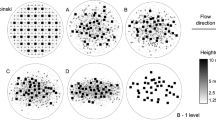Abstract
We present a numerical simulation of drag partition over rough surfaces. A computational fluid dynamics model is applied with high resolution to simulatingturbulent flows over arrays of roughness elements positioned on asmooth surface. The skin drag on the surface and the pressure drag on the roughnesselements are computed. The simulated drag partition compares well with wind-tunnelmeasurements and theoretical estimates for similar rough surfaces. This confirms that the computational approach offers an alternative to wind-tunnel and field experiments in studying drag and drag partition. The model is then applied to studying drag partition over rough surfaces with various roughness configurations. It is shown that drag partition depends not only on the magnitude of the roughness frontal area but also on the sizes and arrangement of roughness elements, because (1) the pressure drag coefficient is sensitive to roughness-element dimensions and (2) the arragement of roughness elements lead to different interferences of turbulent wakes. The impact ofthe latter factor is not insignificant.
Similar content being viewed by others
References
Arya, S. P. S.: 1975, 'A Drag Partition Theory for Determining the Large-Scale Roughness Parameter and Wind Stress on Arctic Pack Ice'. J. Geophys. Res. 80, 1173-1184.
Judd, M. J., Raupach, M. R., and Finnigan, J. J.: 1996, 'A Wind Tunnel Study of Turbulent Flow around Single and Multiple Windbreaks, Part I: Velocity Fields', Boundary-Layer Meteorol. 80, 127-165.
Li, A.: 2002, Computational Simulation of Sediment Entrainment and Transport in Atmospheric Surface Layer, Ph.D. Thesis, The University of New South Wales.
Li, Y. and Baldacchino, L.: 1995, 'Implementation of Some Higher-Order Convection Schemes on Non-Uniform Grids', Int. J. Numer. Meth. Fluids 21, 1201-1220.
Marshall, J. K.: 1971, 'Drag Measurements in Roughness Arrays of Varying Density and Distribution', Agric. Meteorol. 8, 269-292.
Patton, E. G., Shaw, R. H., Judd, M. J., and Raupach, M. R.: 1998, 'Large-Eddy Simulation of Windbreak Flow', Boundary-Layer Meteorol. 87, 275-306.
Raupach, M. R.: 1992, 'Drag and Drag Partitioning on Rough Surfaces', Boundary-Layer Meteorol. 60, 375-395.
Taylor, P. A.: 1988, 'Turbulent Wakes in the Atmospheric Boundary Layer', W. L. Steffen and O. T. Denmead (eds.), Flow and Transport in the Natural Environment: Advances and Applications, Springer-Verlag, Berlin, New York, 270-292.
Wooding, R. A., Bradley, E. F., and Marshall, J. K.: 1973, 'Drag Due to Regular Arrays of Roughness Elements of Varying Geometry', Boundary-Layer Meteorol. 5, 285-308.
Wyatt, V. E. and Nickling, W. G.: 1997, 'Drag and Shear Stress Partitioning in Sparse Desert Creosote Communities', Can. J. Earth Sci. 34, 1486-1498.
Author information
Authors and Affiliations
Rights and permissions
About this article
Cite this article
Li, A., Shao, Y. Numerical Simulation of Drag Partition over Rough Surfaces. Boundary-Layer Meteorology 108, 317–342 (2003). https://doi.org/10.1023/A:1024179025508
Issue Date:
DOI: https://doi.org/10.1023/A:1024179025508




